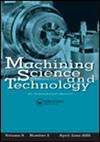非电参数对钛合金线切割轮廓精度和表面特性的影响
IF 2.6
4区 工程技术
Q2 ENGINEERING, MANUFACTURING
引用次数: 2
摘要
摘要在电火花加工复杂结构时,线滞是造成某些几何形状和轮廓不准确的主要原因。以往的研究主要集中在电火花加工过程中电气参数对加工性能和精度的影响,而非电气参数对边角和轮廓精度的影响尚未得到全面的研究。本研究的目的是研究非电参数对Ti-6Al-4V合金电火花线切割过程中几何和轮廓精度以及表面和亚表面特征的影响。设计了包含45°、90°和112.5°角以及薄壁截面的复杂零件,用于测量切口精度。结果表明,随着线材张力的增大,轮廓精度有所提高。然而,过高的钢丝张力导致在尖锐的角落弯曲路径。线材张力对厚度较高的工件的影响更为明显。过高的送丝速度会降低目标角度的精度,特别是对于较低厚度的工件。越薄的工件,切缝宽度越小,切缝宽度随送丝速度和丝张力的降低而增大。而丝张力和送丝速度对表面粗糙度没有影响,更高的表面送丝速度会增加表面粗糙度。由于更快的冷却,更高的钢丝张力导致更高的表面裂纹。随着表面进给量的增加,由于不稳定性的增加,电弧脉冲的百分比增加,这导致表面更粗糙,地下β相的百分比增加。本文章由计算机程序翻译,如有差异,请以英文原文为准。
Effects of non-electrical parameters on profile accuracies and surface characteristics during wire-EDM of titanium alloy
Abstract Wire lag plays a major role in causing inaccuracies in certain geometrical shapes and profiles during machining of complex structures using wire-EDM. While previous studies focused on investigating effects of electrical parameters on machining performance and accuracy during wire EDM, the effects of non-electrical parameters on corner and profile accuracies have not been studied comprehensively. The objective of this study is to investigate effects of non-electrical parameters on the geometric and profile accuracies as well as surface and subsurface characteristics during WEDM of Ti-6Al-4V alloy. A complex part including corners with 45°, 90°, and 112.5° as well as thin wall section for measuring the kerf accuracy was designed. It is found that the profile accuracy improves as the wire tension increases. However, too high wire tension results in curved path in the sharp corners. The effect of wire tension is more pronounced on the workpiece with higher thickness. Too high wire feed rate reduces the accuracy for target angles, especially for lower thickness of workpiece. The kerf width is smaller for thinner workpiece and improves with lower wire feed rate and wire tension. While the wire tension and wire feed rate do not have an impact on surface roughness, higher surface feed rate increases surface roughness. Higher wire tensions lead to higher surface cracking due to more rapid cooling. With increase of surface feed, the percentage of arcing pulses increases due to increased instability, which results in rougher surface and increased percentage of beta phases at the subsurface.
求助全文
通过发布文献求助,成功后即可免费获取论文全文。
去求助
来源期刊

Machining Science and Technology
工程技术-材料科学:综合
CiteScore
5.70
自引率
3.70%
发文量
18
审稿时长
6 months
期刊介绍:
Machining Science and Technology publishes original scientific and technical papers and review articles on topics related to traditional and nontraditional machining processes performed on all materials—metals and advanced alloys, polymers, ceramics, composites, and biomaterials.
Topics covered include:
-machining performance of all materials, including lightweight materials-
coated and special cutting tools: design and machining performance evaluation-
predictive models for machining performance and optimization, including machining dynamics-
measurement and analysis of machined surfaces-
sustainable machining: dry, near-dry, or Minimum Quantity Lubrication (MQL) and cryogenic machining processes
precision and micro/nano machining-
design and implementation of in-process sensors for monitoring and control of machining performance-
surface integrity in machining processes, including detection and characterization of machining damage-
new and advanced abrasive machining processes: design and performance analysis-
cutting fluids and special coolants/lubricants-
nontraditional and hybrid machining processes, including EDM, ECM, laser and plasma-assisted machining, waterjet and abrasive waterjet machining
 求助内容:
求助内容: 应助结果提醒方式:
应助结果提醒方式:


